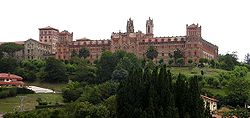Comillas
| Comillas | |||
|---|---|---|---|
| Municipality | |||

Building of Comillas Pontifical University
|
|||
|
|||
 Location of Comillas |
|||
| Location in Spain | |||
| Coordinates: 43°23′13″N 4°17′22″W / 43.38694°N 4.28944°WCoordinates: 43°23′13″N 4°17′22″W / 43.38694°N 4.28944°W | |||
| Country |
|
||
| Autonomous community |
|
||
| Province | Cantabria | ||
| Comarca | Western coast of Cantabria | ||
| Judicial district | San Vicente de la Barquera | ||
| Capital | Comillas | ||
| Government | |||
| • Alcaldesa | María Teresa Noceda Llano (2007) (PRC) | ||
| Area | |||
| • Total | 18.61 km2 (7.19 sq mi) | ||
| Elevation | 23 m (75 ft) | ||
| Highest elevation | 210 m (690 ft) | ||
| Lowest elevation | 0 m (0 ft) | ||
| Population (2008) | |||
| • Total | 2,483 | ||
| • Density | 130/km2 (350/sq mi) | ||
| Demonym(s) | Comillano, na | ||
| Time zone | CET (UTC+1) | ||
| • Summer (DST) | CEST (UTC+2) | ||
| Website | |||
Comillas is a small township and municipality in the northern reaches of Spain, in the autonomous community of Cantabria. The Marquisate of Comillas, a fiefdom of Spanish nobility, holds ceremonial office in the seat of power at a small castle which overlooks the town. The Comillas Pontifical University was housed here before it moved to Madrid, and the old university buildings are among the finest examples of architecture in the town. Besides this, there are many notable medieval and baroque buildings.
Comillas was first inhabited in prehistoric times when the caverns that are plentiful in the area were used as shelters. The Neolithic inhabitants left behind them rock paintings that depicted the animals they hunted. Magdalenian and Bronze Age artefacts have been found in nearby Ruiseñada, and there was an ancient mine at La Molina in which utensils and Roman coins have been found as well as an altar dedicated to the god Jupiter. Arrowheads have also been found here. On the border between Comillas and Ruiloba, heaps of shells have been found showing that the ancient people, besides hunting, specialised in collecting food from the sea.
The remains of the medieval castle of Peña del Castillo are still visible and another castle later occupied the same strategic site. The earliest documents relating to the town date to the eleventh century, although most of them were destroyed later in a fire at the town hall. Garcilaso de la Vega built a tower on the coast to demonstrate the towns dominance in maritime affairs. After the conclusion of the Valles Lawsuit against the Duke of Infantado in 1581, Comillas became part of the Province of Nine Valleys, a judicial and administrative body. Historically, the town was one of four towns making up the Alfoz of Lloredo. The town is sometimes known as the "Town of the Bishops", because five priests who were born here went on to become bishops in several different dioceses during the Middle Ages.
Early in the twentieth century, the first marquis Antonio López y López invited King Alfonso XII to his mansion at Comillas and the town became popular with the aristocracy; the architect Joan Martorell built the enormous Palacio de Sobrellano on the instructions of the marquis.
...
Wikipedia



